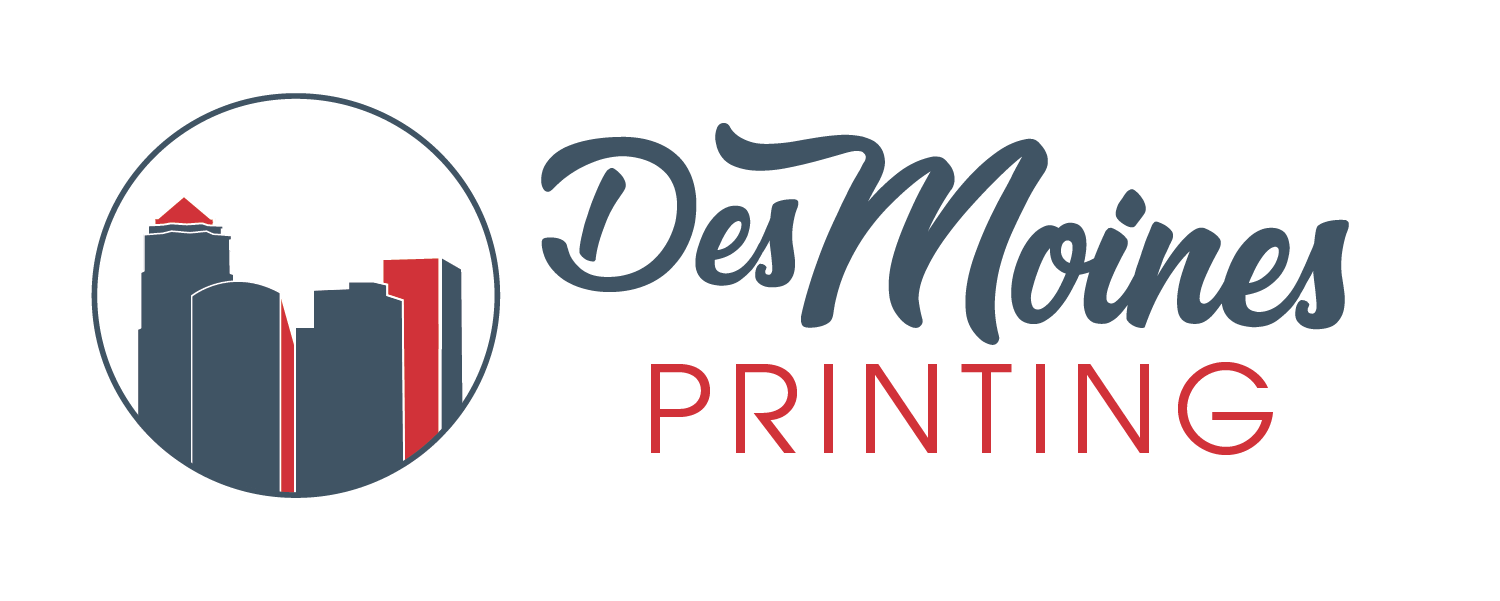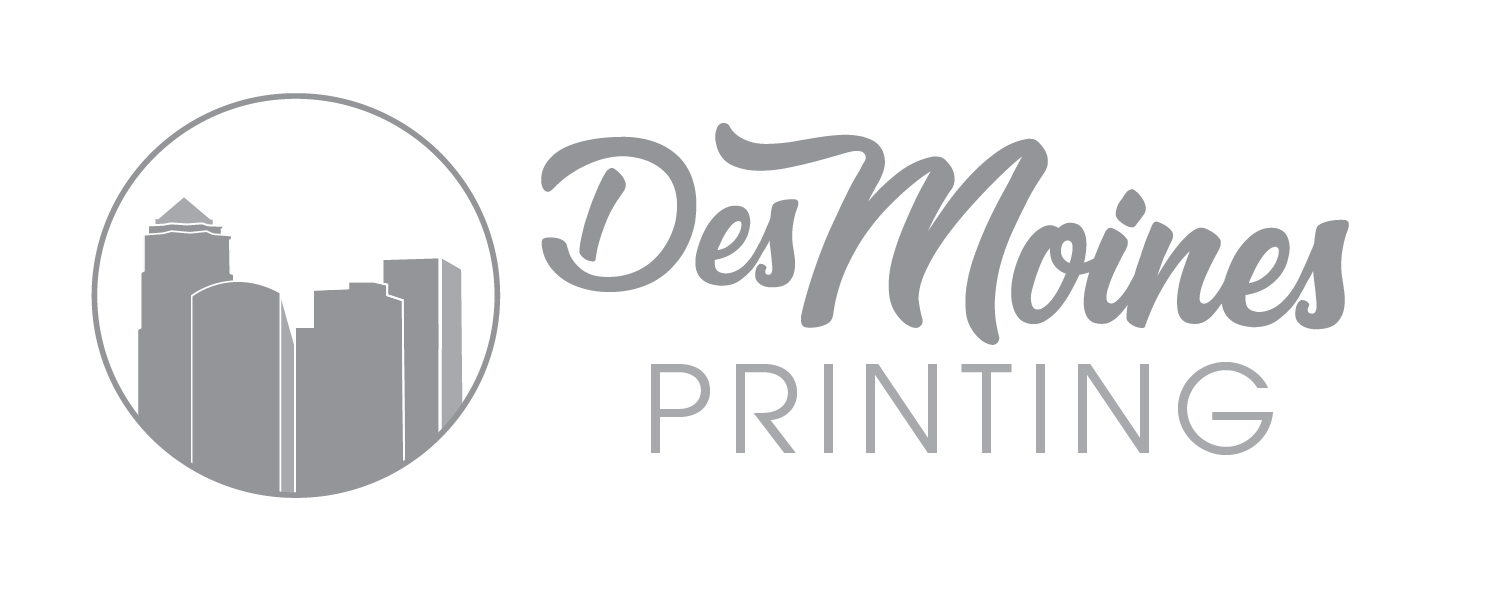As in any industry, the print industry uses its own unique language that can be confusing to people unfamiliar with the terminology. In order to effectively order printed materials, you need to understand some basics including paper stocks, colors, paper coatings, and maybe even a little bit about bindery options like scoring and folding. The information contained within this document is meant to provide some general knowledge to individuals who need to do basic print ordering.
At Des Moines Printing, we have worked with over 400 customers of varying sizes, from startups to Fortune 500 companies. Our experience is that more often than not, the person tasked with ordering printed materials has little if any experience with the terminology used within the print industry. This communication gap can lead to confusion and frustration in the ordering process and increase the potential for errors. At Blue Frog we try to help our customers to build a basic knowledge of print terminology so we can better deliver the products they envision.
Here we define some basic print industry terms. Learning these words and phrases will give you the tools you need to confidently order printed materials for your business!
There are 4 basic pieces to a standard print order.
1. Dimensions: What is the size of your piece?
2. Paper Stock: On what weight/type of paper is it to be printed?
3. Paper Coatings: What is the finish on the paper?
4. Color: What colors are to be used?
Dimensions
I don't believe we need to define dimensions other than to know the size piece you want when ordering.
That being said, it's important if you are mailing that you are aware of USPS mailing requirements. If you don't know, you should ask your printer when placing the order. Also if you are inserting your piece into an envelope you need to be aware of the various envelope options that are available. If you are doing bulk mailing with an envelope, make sure you tell your printer upfront as they will look for what is called "machineable" envelopes. Machineable envelopes can be run through an inserting machine so each piece does not need to be hand-inserted and this will save you significant money on your job. Some envelope sizes are either unavailable or very difficult to find in the machineable variety so it's critical that you plan ahead.
Paper Stocks
There are 2 basic types of paper stock used in commercial printing, “text” and “cover.” Learning the difference between these two types of paper is pretty simple.
Cover
Also known as “card stock,” this is a thicker paper used for items like business cards, postcards, and booklet covers.
Text
Also known as “book,” this is a thinner stock than cover and is often used for sales sheets, tri-fold pamphlets, and magazines.
Paper Coatings
Gloss
Paper stock coated with a gloss finish has a shiny appearance and allows for crisp, vibrant images.
Matte
This paper stock is coated with a flatter finish than gloss.
Dull
Dull paper stock is slightly smoother than matte.
Uncoated
Since coatings act as a barrier on the paper, uncoated stocks are significantly easier to write on. People often prefer uncoated stocks for business cards, appointment cards, reply cards, or any other piece on which someone may want to write.
Colors
This is something that causes a lot of confusion for people unfamiliar with the printing process. In full color printing, 4 colors are combined to create full color images. The colors created by this method are called “process” colors. The four colors used in 4-color process printing are CYAN, MAGENTA, YELLOW, and BLACK. These are often referred to simply as CMYK. When ordering full color printed items, the terminology used for 4-color process jobs are as follows:
 4/0, pronounced “4 over zero”: This would be a piece that is full color on the front but blank on the back, such as most business cards.
4/0, pronounced “4 over zero”: This would be a piece that is full color on the front but blank on the back, such as most business cards.
4/4, pronounced “4 over 4”: This term reflects a piece that is full color on both sides, such as a promotional postcard you might receive in the mail.
Some colors are difficult or even impossible to reproduce using 4-color process printing. In this case, inks are mixed to create a desired color called a “PMS” color, which stands for “Pantone Matching System”. Some colors, such as metallics, can only be printed as PMS colors. When discussing jobs with PMS colors they may be referred to as...
1/0, pronounced “1 over zero”: In this case, the job would be printed with 1 PMS color on the front and a blank back.
2/0, pronounced “2 over zero”: This would be a combination of 2 PMS colors on the front and a blank back.
Now it gets a little bit more complex.
5/4, pronounced “5 over 4”: When a PMS color, silver, for example, is used within a full-color piece, a 5th color is added to the press. The combination of the silver with the other 4 colors on the front of the piece and a standard 4-color process on the back gives us an item with 5 colors on the front and 4 on the back.
Confused? Just remember this. 4 color = full color. That will get you through 90% of print jobs.
With your new knowledge of print terminology, you should be able to tell your print partner exactly what it is you are looking for.
Now instead of this...
“I need 500 postcards on thick shiny paper that are full color on both sides.”
You can sound like this...
“I need 500 postcards, 5.5X8.5 printed 4/4 on 100# gloss cover.”
Other useful terminology
Bindery: This includes various finishing activities such as scoring, folding, saddle stitching, foil stamping, embossing, debossing, die-cutting, and perfect binding.
Bleed: The bleed gives the printer a small amount of space around the edge of an image to account for movement of the paper and design inconsistencies. Artwork and background colors can extend into the bleed area, ensuring that after trimming, no unprinted edges occur in the final trimmed document.
Collating: organizing paper in a predefined order
C1S: This is an abbreviation for a coated paper, “Coated 1 Side.” C2S stands for “Coated 2 Sides.”
Crop Marks: the marks a designer puts on artwork to show the printer where the cuts should be made
Die: a device used in bindery for cutting, scoring, stamping, embossing, and debossing
Gang: a combination of multiple jobs run on the same sheet during one press run
M: M is the Roman numeral for 1000, used to denote the number of pieces to be printed. For instance, 25M = 25,000 pieces
Proof: a sample made to check for errors in copy, color, and layout intended to represent the appearance of the final piece
Saddle Stitched: stapled along the spine, as a magazine.
Scoring: creating a crease on the fold of a piece of paper. Scoring helps keep paper from cracking when folded.
Up: When something is printed 2 up, it means that there are 2 images printed on one sheet of paper. Likewise, if an item is printed 4 up, 4 images are printed on one sheet of paper. Generally, as the number of pieces per sheet increase, the cost per piece goes down.
UV coating: a coating applied to a printed sheet that is cured with ultraviolet light
Variable Data Printing: Printing with an image or text that changes from piece to piece often used to add a level of personalization to each individual piece.
Varnish: liquid-applied for protection and for a desired visual effect
While there is certainly a lot more we could get into, this is meant to be an introductory level document. If you have further questions please don't hesitate to reach out to us!
For assistance with all of your printing needs, contact us today.


